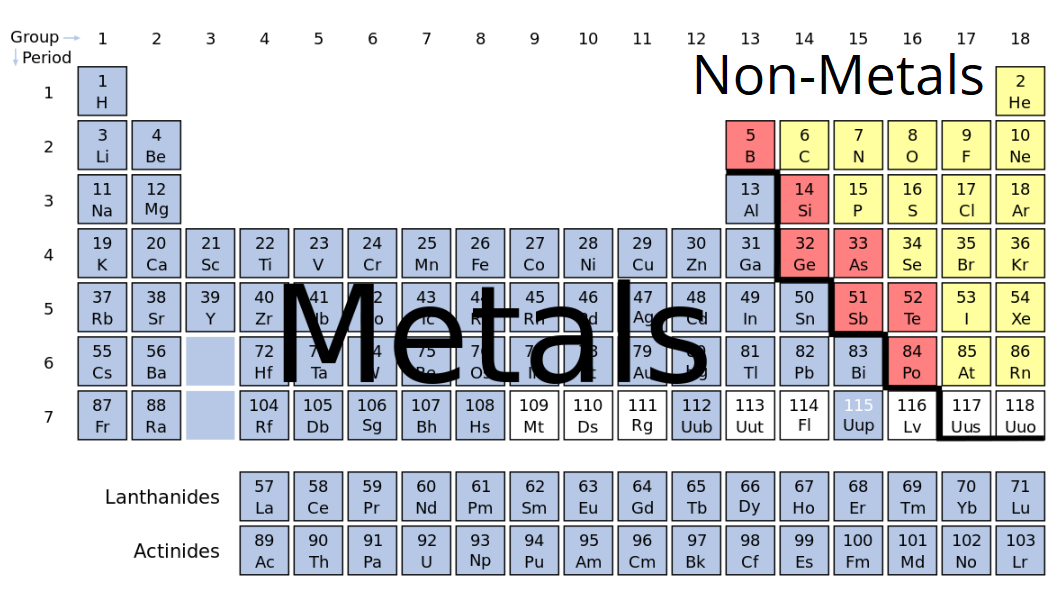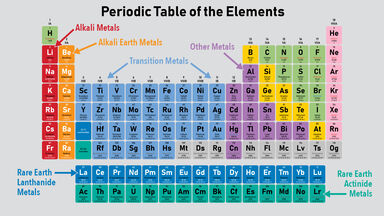Elements to the left of the line are considered metals. This line is often referred to as the staircase because of its shape.
Classification Of Elements In The Periodic Table Color Coding Yellow Download Scientific Diagram
The alkaline earth metals are found in column 2 on the left side of the Periodic Table.

Where are the metals on the periodic table. These are the representative elements or main group elements. This periodic table groups elements according to type. All of the metals are grouped.
There are only two exceptions ie two elements in that sequence between number 5 and number 84 that are not metals. The majority of elements on the periodic table are metals. In the periodic table the vertical columns are called groups and the horizontal rows are called periods.
In the periodic table you can see a stair-stepped line starting at Boron B atomic number 5 and going all the way down to Polonium Po atomic number 84. Also many periodic tables have a stair-step line on the table identifying the element groups. Periodic table in chemistry the organized array of all the chemical elements in order of increasing atomic number.
An elements position on the Periodic Table tells us whether it is a metal a non-metal or a semi-metal. The metalloids separate the metals and nonmetals on a periodic table. The archetypal transition metals and the physically and chemically weak post-transition metals.
Except for Germanium Ge and Antimony Sb all the elements to the left of that line can be classified as metals. H in the top left hand corner. The less reactive alkaline earth metals lanthanides and radioactive actinides.
The first 94 elements of the periodic table are naturally occurring while the rest from 95 to 118 have only been synthesized in laboratories or nuclear reactors. When the elements are thus arranged there is a recurring pattern called the periodic law in their properties in which elements in the same column group have similar properties. Most periodic tables print a thick black line to show the division between metals and nonmetals.
The periodic table is the tabular arrangement of all the chemical elements on the basis of their respective atomic numbers. The highlighted elements are considered the metal elements. Look up chemical element names symbols atomic masses and other properties visualize trends or even test your elements knowledge by playing a periodic table game.
The six alkaline earth metals are. The periodic table also known as the periodic table of elements is a tabular display of the chemical elements which are arranged by atomic number electron configuration and recurring chemical propertiesThe structure of the table shows periodic trendsThe seven rows of the table called periods generally have metals on the left and nonmetals on the right. If you look at the Periodic table you will find that the metal elements are located between atomic number 5 Boron B all the way to atomic number 84 Polonium Po.
Interactive periodic table with up-to-date element property data collected from authoritative sources. The line begins at boron B and extends down to polonium Po. Metals are found on the left hand side of the table.
The elements are arranged in order of increasing atomic number with the lightest element hydrogen. And atomic number 52 Antinomy Sb. American Elements is a US.
Metal blue nonmetal yellow or metalloid red. Atomic number 32 Germanium Ge. They are grouped together in the middle to the left-hand side of the periodic table.
Each element has a fixed position on the Periodic Table. Periodic table of the elements materials science and academic information elements and advanced materials data scientific presentations and all pages designs concepts logos and color schemes herein are the copyrighted proprietary rights and intellectual property of American Elements. The metals consist of the alkali metals alkaline earths transition metals lanthanides and actinides.
The modern periodic table is based on the modern periodic law put forward by the English physicist Henry Moseley which states that the properties of. The periodic table also known as the periodic table of elements is organized so scientists can quickly discern the properties of individual elements such as their mass electron number electron configuration and their unique chemical properties. F-block is located below the main table These are the inner transition metals or rare earth elements.
Most elements can be considered metals. Metals reside on the left side of the table while non-metals reside on the right. Get essential facts about the first 20 elements all in one convenient place including the name atomic number atomic mass element symbol group and electron configurationIf you need detailed facts about these elements or any of the higher numbered ones start with the clickable periodic table.
The modern periodic table the one we use now is a new and improved version of certain models put forth by scientists in the 19th and 20th century. Metals comprise the large majority of the elements and can be subdivided into several different categories. From left to right in the periodic table these categories include the highly reactive alkali metals.
They are generally harder and denser than alkali metals have 2 electrons in their outermost s sub-shell and each make a distinct color in their flames. D-block is group 3B to 2B look at the periodic table above because the numbers are not sequential These are the transition metals.

List Of Metals And Non Metals Science Trends

The Parts Of The Periodic Table

How Can You Differentiate Between Metals And Nonmetals On The Periodic Table Socratic

How To Identify Metals Nonmetals And Metalloids On The Periodic Table Youtube

Basic Types Of Metals On The Periodic Table